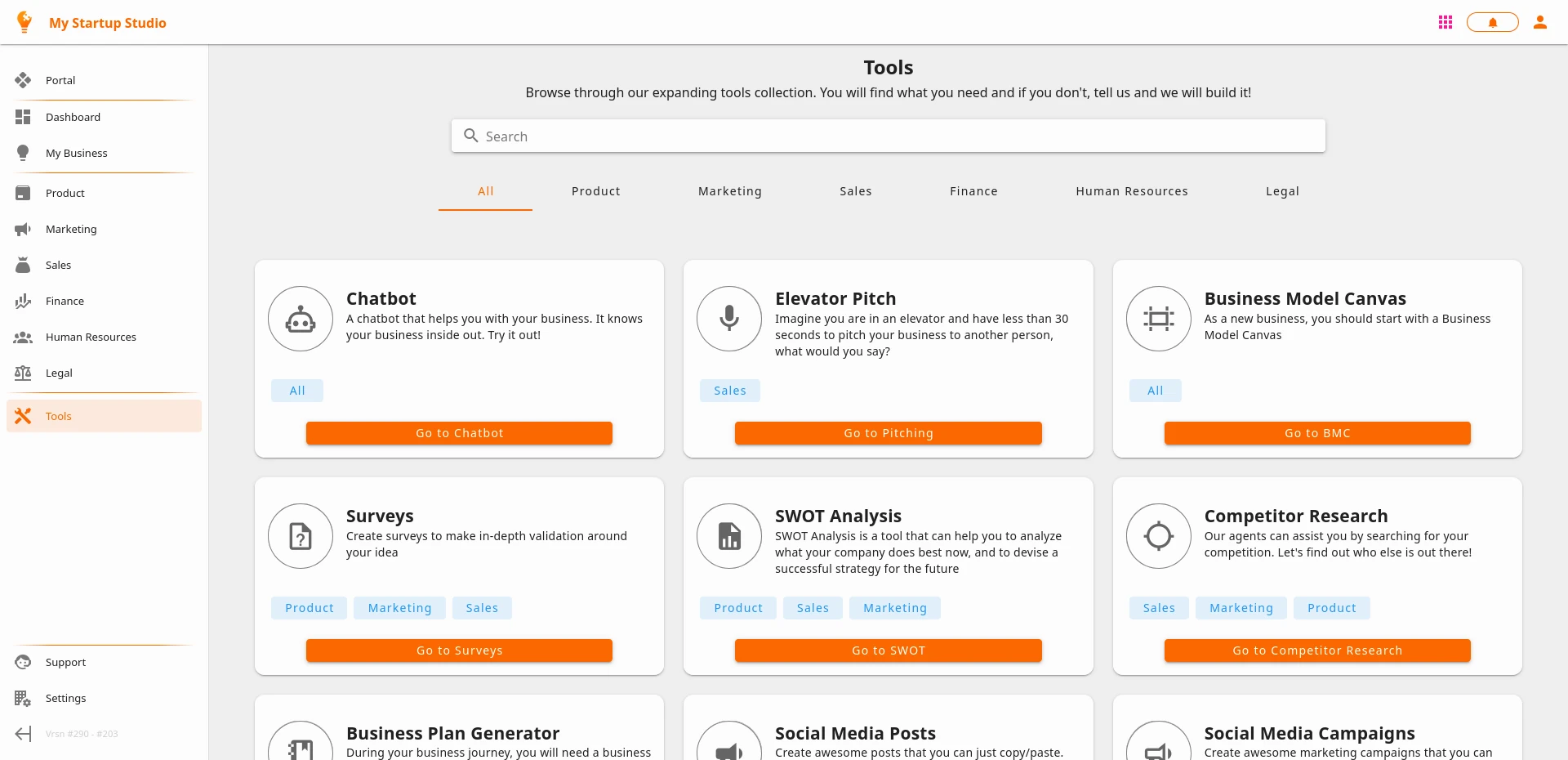Starting a business can be an exhilarating and overwhelming experience. The pressure to take care of- and be responsible for everything can feel daunting. That's why we created The Startup Sprint – a comprehensive guide to help early-stage founders like you turn their ideas into successful businesses. In this blog series, we'll take you on a journey from the initial spark of an idea to achieving product-market-fit and beyond. You'll learn how to validate your concept, build a minimum viable product (MVP), attract customers, and scale your business for long-term success.
Attention: In this blog article, we won't sugarcoat the complexity of entrepreneurship – but we will distill it down to its essence, saving you time, energy, and resources. The Startup Sprint is not about checking boxes or following a formula ; it's about identifying what truly matters in the early stages of startup development. By prioritizing idea validation, MVP development, and PMF achievement, you'll be able to avoid costly mistakes, accelerate your growth, and build a business that has real potential for success
Boost your productivity. Start using our app today.
Save valuable time while learning everything you need

Stage 1: Craft and validate your Idea
There are many business guides and startup resources online, but most focus on the what and the how. They'll tell you to create a business plan, develop a brand, secure funding, and execute a marketing strategy – all essential steps in building a successful business.
However, these resources often overlook the fundamental question: Is my idea worth pursuing? In reality, the vast majority of startups fail because they're built on flawed assumptions or an incomplete understanding of their target market. That's where The Startup Sprint comes in. By focusing on the most critical aspects of startup development, we'll help you validate your idea, build a product that resonates with customers, and ultimately achieve product-market-fit.
Craft Your idea
Your startup's idea is the spark that sets everything in motion. But what happens when you're stuck on how to refine it? Crafting your startup's core concept is the first step towards turning your vision into a reality. To achieve this you have to work on the following things:
- Explore Your Core Concept : Distill your idea down to its essence, ensuring it's concise, focused, and memorable
- Identify Your Unique Value Proposition (UVP) : Determine what sets your startup apart from the competition, making it irresistible to potential customers
- Define a Clear Purpose : Establish a clear direction for your startup, aligning your mission, values, and goals with your core concept
- Perform a quick market research : Before you start with the next step. Try to do a simple research with google, social-media or others to make sure that your UVP is really unique
Our suggestion
Realistically evaluate the professionals, equipment, and materials needed to execute your plans. For instance, if you aim to develop flying cars, assemble a team with expertise in physics, engineering, aerodynamics, and other relevant disciplines.
Build Your Audience
Your startup's product or service is only as good as its potential customers are passionate about it. Building an engaged audience is the secret sauce that can make or break your business.
To get startet you need to do the following things:
- Identify Your Ideal Customer : Understand who they are, what their pain points are, and how they behave in relation to your product or service
- Collect contacts right away : Wether its LinkedIn, Discord, phone-numbers, emails or even some old-school business-cards. What you need is people to reach out to.
- Build loyal Followers : Engage with potential customers. Even if it does not yield any money yet. You probably will need a few who are happy to test your product and give you some feedback
Our suggestion
Start to build an audience at day one. You will need it at every stage of your growing idea. Usually people start with friends and families. If you already have a name and a Logo for your idea, we can only recommend to create accounts on your 2 most favourite socials.
Validate Your Assumptions
Gather feedback from your main audience and others to help your idea grow and avoid spending time on something that nobody wants.
- Create Assumptions : Define what kind of benefits your product will bring or which problem it aims to solve
- Get Feedback : Build forms and get them filled out by your audience. The more the better (in most cases)
- Conduct Learnings : With enough filled out forms you should be able to validate your assumptions or in the worst case learn from it.
Our suggestion
Most startups neglect the power of this process. But especially in the early-stage it will help you to save the most time. This is the best way to figure out if your audience is satisfied with your features as well as what they are willing to pay for it.

Stage 2: Build a Minimum Viable Product (MVP)
The MVP serves as your startup's first product offering, designed to gather valuable feedback from early adopters while keeping development time and resources minimal. Here is what you need to consider when trying to implement your MVP.
Design Thinking
- Empathize: Understand your target audience deeply by conducting interviews, observing behavior, and immersing yourself in their context.
- Define the Problem: Clearly outline the problem you're solving or the need you're meeting based on your understanding of users.
- Ideate: Brainstorm creative solutions addressing the defined problem. Encourage wild ideas!
- Prototype: Create a simple, early version of your product to demonstrate its functionality and value proposition.
Lean Development
- Prioritize Features: Focus on the core features that address users' most pressing needs or deliver your unique value proposition.
- Use Agile Methodologies: Employ techniques like Scrum or Kanban to manage development efficiently.
- Build with Minimal Resources: Leverage no-code/low-code platforms, outsource tasks when possible, and use open-source tools to keep costs down.
Testing and Iteration
- Find Early Adopters: Identify volunteers from your audience eager to test your MVP in exchange for early access.
- Gather Feedback: Collect qualitative (user interviews, usability testing) and quantitative (surveys, analytics) feedback.
- Iterate Rapidly: Based on user feedback, make necessary improvements, additions, or removals to your MVP. Repeat this process continuously.
Our suggestion
Strictly focus on the most important features that allow you to get feedback. Even a simple click-dummy or a 3D-print would already qualify as an MVP that you can give into the hands of your audience to gather feedback. It is important to get the most important mistakes out of the way first. That's what the MVP should be about.
Boost your productivity. Start using our app today.
Save valuable time while learning everything you need

Stage 3: Achieve Product-Market-Fit (PMF)
Product-market fit is the Holy Grail of startups – it occurs when your product solves a real market need, and customers are eager to pay for it.
Identify Your Unique Selling Proposition (USP)
- Highlight What Sets You Apart: Clearly communicate how your product differs from competitors in terms of features, benefits, or approach.
- Articulate Your Value Proposition: Convey the unique value you provide to customers in a concise, compelling way.
Build a brand
- Set it all up: Develop your brand with a name, logo, colors and other variables. Also consider registering a trademark for all its assets and varieties. Especially if you already have brand-recognition and revenue.
- Execute Marketing Campaigns: Start with marketing campaigns to get a controlled flow of traffic. The data created in this process will help you to advance. You can read more about it here in our article What it takes to start a Marketing Campaign.
- Identify High-Growth Channels: Discover which marketing channels (e.g., social media, content marketing, SEO) drive the most growth for your product.
- Optimize Your Funnel: Continuously improve conversion rates at each stage of your sales funnel using techniques like A/B testing, heatmapping, and personalization.
Develop a Pricing Strategy
- Find the Sweet Spot: Balance revenue goals with customer affordability by experimenting with different pricing models (e.g., freemium, tiered plans, bundle pricing).
- Conduct an advanced Market Research: Analyze competitors' pricing and customer sensitivity to price changes.
- Test Your Pricing: Run A/B tests or pilot programs to validate your pricing strategy and gather user feedback.
Scale Strategically
- Team Expansion: Hire dedicated marketing and sales personnel as you grow.
- Budget Allocation: Increase investment in high-performing channels while re-evaluating underperforming ones.
- Expansion into New Markets: Consider international expansion or targeting new customer segments once you've achieved PMF in your initial market.
Measure and Monitor
- Monitor Key Metrics: Regularly review customer acquisition cost (CAC), lifetime value (LTV), churn rate, and other KPIs to assess PMF progress.
- Gather Continuous Feedback: Collect user reviews, conduct regular interviews with customers, and maintain open communication channels to stay attuned to evolving market needs.
- Use the Sean Ellis Test: Ask customers how they'd feel if they could no longer use your product, and track the percentage who respond "very disappointed."
Our suggestion
Keep re-iterating on everything from stage 1 and 2 to strenghen your mindset around your product. At this stage you want to know all the benefits as well as all weaknesses of your product. Also keep an eye out on emerging trends and competitors.



